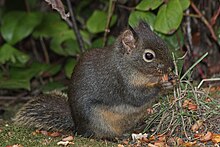Tamiasciurus douglasii
| Douglas squirrel Tamiasciurus douglasii |
|
|---|---|
 |
|
| Scientific classification | |
| Kingdom: | Animalia |
| Phylum: | Chordata |
| Class: | Mammalia |
| Order: | Rodentia |
| Family: | Sciuridae |
| Genus: | Tamiasciurus |
| Species: | T. douglasii |
| Binomial name | |
|
Tamiasciurus douglasii (Bachman, 1839) |
|
| Subspecies | |
|
|
The Douglas squirrel (Tamiasciurus douglasii) is a pine squirrel found in the Pacific coastal states of the United States as well as the southwestern coast of British Columbia in Canada. It is sometimes known as the chickaree or pine squirrel, although these names are also used for the American red squirrel. Variant spellings of the common name are Douglas' squirrel and Douglas's squirrel. The Native Americans of Kings River called it the "Pillillooeet", in imitation of its characteristic alarm call.
John Muir described the Douglas squirrel, Tamiasciurus douglasii, as "by far the most interesting and influential of the California Sciuridæ". Adults are about 33 cm in length (including its tail, which is about 13 cm long), and weigh between 150 and 300 grams. Their appearance varies according to the season. In the summer, they are a grayish or almost greenish brown on their backs, and pale orange on the chest and belly, while legs and feet appear brown. In the winter, the coat is browner and the underside is grayer; also, the ears appear even tuftier than they do in summer. Like many squirrels, Douglas squirrels have a white eye ring.
Mating can occur as early as February. Gestation is about four weeks, and the young (which are altricial) are weaned at about eight weeks of age. There may be up to six kits in a litter, though four is more usual. In the southern and lower parts of their range they produce two litters each year.
Douglas squirrels live in coniferous forest habitats along the Pacific Coast, from the Sierra Nevada (mountains) of California, northwards to the southwestern coast of British Columbia. Tamiasciurus douglasii prefer old-growth forests or mature second-growth forests, and some authors regard them as dependent on its presence.
...
Wikipedia

